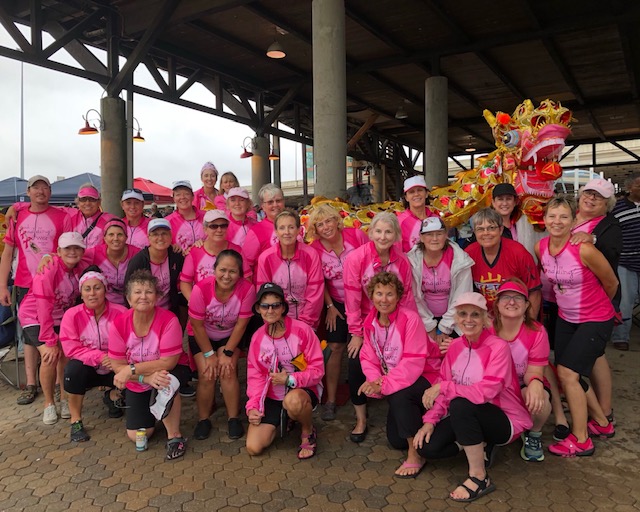About Dragon Boating

Dragon boat racing originated in Ancient China as one of the earliest known forms of boat racing, and is celebrated at festivals and races throughout the world. This mythical celebration is a symbol of Chinese culture and spirit and is one of the three largest festivals in China. The roots of dragon boat racing go back over 2,000 years to the southern provinces of China. Legend has it that Qu Yuan, a scholar and advisor to the emperor of the Chu Kingdom, jumped into the Mei Lo (Mi Luo) River in despair and protest against government corruption. Local fishermen raced out in their boats to save him. They beat drums and pounded their paddles on the river’s waters and threw rice dumplings wrapped in silk into the river to distract the water dragons to keep them from eating Qu Yuan’s body. Dragon boating evolved from the re-enactment of this legend at annual festivals.
Boats and Races
The dragon boating experience has been described as a “floating support group” for women with breast cancer. It all began with a study involving one boat of 25 women. In 1996, Dr. Don McKenzie, a sports medicine physician at the University of British Columbia, launched Abreast in a Boat. He believed that women could get involved in a sport like dragon boating if they followed a special upper-body exercise and training program. They could enjoy active lives and avoid the onset or worsening of lymphedema. Participants in his study were monitored closely by a sports medicine physician, a physiotherapist, and a nurse. Dr. McKenzie’s theory was right. No new cases of lymphedema occurred and no existing cases got worse. Since 1996 Dragon boat racing by breast cancer survivors has grown across the world with Canada leading the way.
Dragon Boating and BCS
A dragon boat is a large, canoe-like craft made from wood and fiberglass that is colorfully painted and decorated with a dragon’s head on the front and a tail on the back. Size varies, but boats hold between 16 and 24 paddlers with an average of 20 paddlers. Paddlers are seated two per row and paddle continuously on the same side for the duration of the race. A drummer and steersperson accompany the paddlers to motivate the crew and keep the boat on track. Paddles are wood or carbon fiber. Races are held at various locations around the world, but usually in somewhat sheltered venues as dragon boats are not quite seaworthy. The average race course is 500 meters and can have between 4 and 10 boats. Dragon boat racing is one of the fastest growing sports in the world. It is truly an impressive sight to see an elaborately adorned dragon boat surging towards the finish line with its engine of 20 paddlers pulling hard with every stroke in perfect unison to the drummer’s beat and the calls of the steersperson. Combine the competition and excitement of the races with the fun and atmosphere of the cultural festivities that typically occur at a dragon boat festival, and you have a great event for participants and spectators of all ages.
The Paddlers
The paddlers sit facing forwards and use a specific type of paddle. The leading pair of paddlers, or “strokes” or “strokers” set the pace for the team. All other paddlers synchronize their strokes to the stroke paddlers only, for if they synchronize to the paddler sitting just ahead, the result of the split second difference of delay can result in a caterpillar or centipede effect whereby each successive pair of blades hits the water a fraction of a second behind the blades in front, with the collective stroke of the boat falling out of synchronization. Very experienced paddlers will feel the response of the boat and its surge or resistance through the water via the blades of their paddles, and will adjust their reach, and the catch of their blade tips, in accordance with the power required to match the acceleration of the hull through the water at any given moment.
The Drummer and Drumming
The drummer is considered the “heartbeat” of the dragon boat, and leads the crew throughout a race with the rhythmic beating of a drum to indicate the timing and frequency of paddling strokes (i.e. the cadence, picking up the pace, slowing the rate, etc.) The drummer may issue commands to the crew through a combination of hand signals and voice calls, and also generally exhorts the crew to perform at their peak. A drummer/drummers is mandatory during racing events, but if he or she is not present during training, it is typical for the steerer to direct the crew. Good drummers should be able to synchronize the drumming cadence with the strokes of the leading pair of paddlers, rather than the other way around. As a tail wind, head wind or cross wind, may affect the amount of power needed to move the boat at hull speed throughout a race, a drummer should also be aware of the relative position of the dragon boat to other boats, and to the finish line, in order to correctly issue commands to the crew as to when to best surge ahead, when to hold steady and when to peak for the finish. An expert level drummer will be able to gauge the power of the boat and the paddlers through the sensation of acceleration, deceleration, and inefficiencies which are transmitted through the hull (i.e. they will physically feel the boat action through their feet and gluteus maximus muscles). The dragon boats with 20 paddlers has the drum located just aft of the dragon headed prow.
The Steersman
The steersman, also known as the coxswain, helm, sweep, or tiller, controls the dragon boat with a steering oar similar in function to a tiller which is mounted at the rear of the boat. The steersman may work with the drummer to call out commands during a race.

